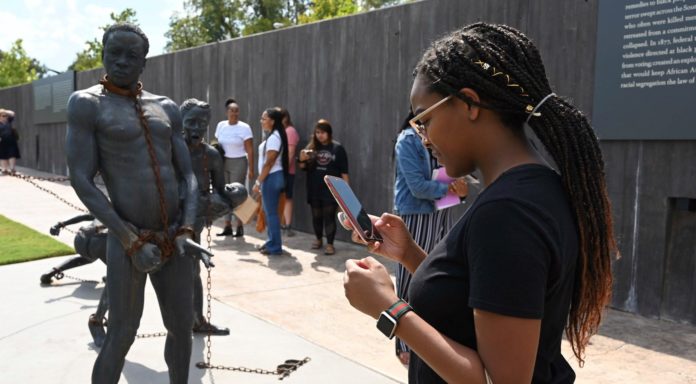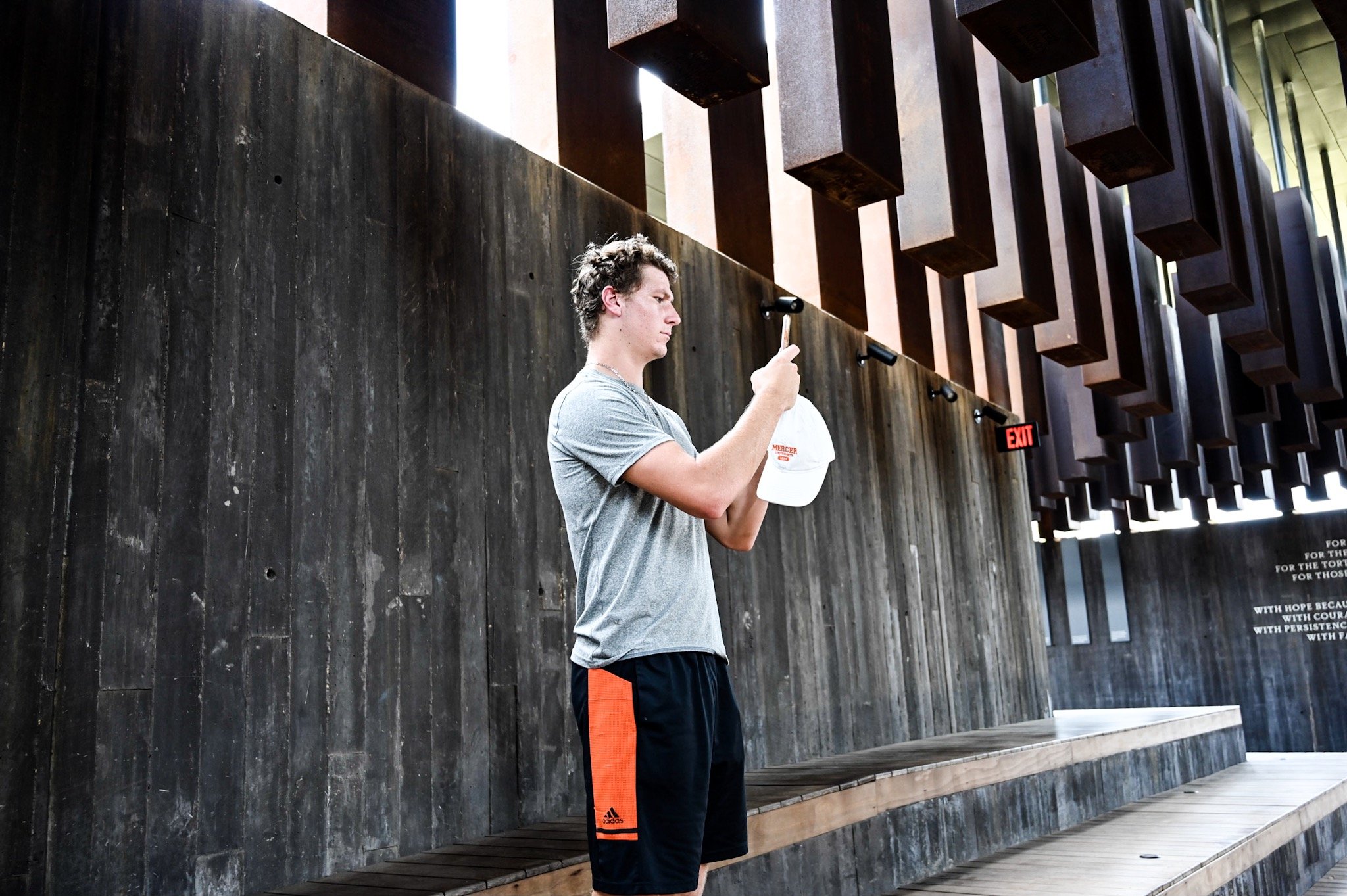
Dr. Michele Prettyman is teaching Mercer students how to find their voices as storytellers and appreciate the stories that others have to tell.
This is the fourth year that Dr. Prettyman, assistant professor of media studies and Africana studies, has taught digital storytelling, but it’s the first time the course has included a trip to the Legacy Museum and the National Memorial for Peace and Justice in Montgomery, Alabama.
The course focuses on the art of storytelling and shows the tools that can be used to create meaningful narratives about the world around us. Students learn how to create compelling nonfiction stories with modern digital technologies, including audio, photography, video and interactive graphics.
“It’s not all about technology,” Dr. Prettyman said. “It is about yourself as part of a larger community. As storytellers, our job is to rewrite narratives about people and communities that have been marginalized by storytelling, or whose stories haven’t been told in a more complete and thoughtful way.”
Class members gain proficiency in smartphone technologies as well as computer/software resources, including editing software Adobe Premiere; analyze narratives presented in different media forms, such as short films, feature films, documentary films and podcasts; learn about the basic elements of film; and develop an understanding of media literacy and the ethical obligations of storytellers.
This general education course draws students from a variety of majors and with varying technological experience, Dr. Prettyman said. It’s an interactive and collaborative course that involves lectures, group work, field work as students practice their skills, and lots of discussion.
“To be able to tell stories, you have to understand how people digest stories and what methods are used to tell them in the best way,” said Yasmeen Hill, a junior double-majoring in journalism and media studies. “I definitely feel like I am learning all those things from taking this class.”
During class Sept. 16, Dr. Prettyman and her students looked at still images they took on campus to represent certain themes. They interpreted and gave feedback on the photos and asked questions about them. One student took a photo of the fountain at Tattnall Square Park at 3 a.m. Another showed a photo of a Mercer soccer fan hugging a player after a game.
“I think the thing I like most is seeing different people’s insight on a lot of different things,” said sophomore Devin Dickinson, a global development major. “I’ve enjoyed seeing the way different people tell stories and how to dissect them.”
Dr. Prettyman usually invites a few guests to speak with her digital storytelling class. Dr. Matt Harper, assistant professor of history and Africana studies, has talked with students about local historical projects he’s involved in, and Hannah Vann Nabi, associate director of Mercer’s Quality Enhancement Plan (QEP), has spoken about the growth and challenges of the Macon and Mercer communities.

On Sept. 26, about 70 people on two charter buses traveled to the Legacy Museum: From Enslavement to Mass Incarceration and the National Memorial for Peace and Justice. Participants included Dr. Prettyman’s digital storytelling students, students in Dr. Laura Simon’s sociology of race and ethnicity class, other Mercer faculty and staff members, and community members. The trip was supported through a Research That Reaches Out/QEP grant.
“The design is like nothing you’ve ever seen,” Dr. Prettyman said. “It’s really just inundating you with information and experiences that help us to understand the fullness of how racial terrorism operated in this country for many decades.”
The multi-sensory museum uses interactive media, sculpture, videography and exhibits to detail America’s history of racial injustice. The memorial features hanging tombstones that symbolize the thousands of lynching victims in the United States.
“I was definitely dealing with a lot of emotions when I was there,” Hill said. “Having all of it set up in chronological order, it just really documented what it was like. I was just being faced with a physical representation of black suffering.”
Dickinson said it was overwhelming and shocking to see the country’s black history laid out like this. The museum is a “narrative of how slavery still affects the world” and shows things that have gone unseen for far too long.
“With the trip component, certainly you want students to be exposed to kind of a living history that they might not have known about otherwise,” Dr. Prettyman said. “I want them to be able to make connections. I want them to have a more tangible sense of how those things are actively shaping our own social lives. The museum does a good job of making those things very tangible.”
Students in both the sociology and digital storytelling courses are applying their museum experiences to projects. In Dr. Prettyman’s class, students are working on group projects related to an issue they were exposed to at the museum that’s also connected to Middle Georgia. They will integrate interviews, still images, moving images, archival footage and other elements into creative stories that are five to seven minutes long. They’re not journalistic pieces but nonfiction narratives, similar to short documentary films.
Hill’s group was thinking about a project that focuses on either medical discrimination or prison sentences for black youth. Dickinson’s group was looking into unequal medical care for women in prison.
One of the things the course has addressed is the danger of telling the single story and not giving people enough context. Dickinson said he has learned “how to tell a narrative as completely as possible, while also leaving room for people to want to research more.” He will be able to apply that knowledge and perspective to future classes and assignments.









